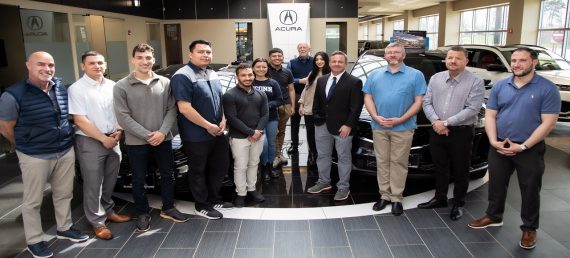Measuring Honda’s Environmental Impact 2021
At Honda, we take great care to consider the environmental impact of everything we do, and everything we make. From being a leader in the fuel economy of our fleet of vehicles to powering our US manufacturing operations with renewable energy, we are focused on a sustainable future. These efforts include transparent reporting of our environmental performance in the North American region and globally.
As the largest manufacturer of engines in the world, we strive to ensure those engines – as well as the products they power – are clean, fuel efficient and emit the least possible emissions. This commitment drove Honda to be one of the first companies to declare its own Environmental Statement in 1992. In 2011, we went one-step further when we issued our Environmental and Safety Vision.
Since 2005, we have annually reported our environmental performance data. For the fiscal year ending March 31, 2021, all of Honda’s of its current environmental data as it pertains to manufacturing can be accessed in this spreadsheet while all of the in-use data for Honda’s auto, powersports and power equipment products, including fuel mileage and emissions, can be found here.
Honda’s Environmental Goals
2030 – 2040 Goal
In 2021, Honda announced key targets for sales of electrified vehicles in North America, with a plan to make battery-electric and fuel cell electric vehicles to represent 100% of its vehicle sales by 2040, progressing from sales of 40% by 2030 and 80% by 2035. To accelerate toward these targets, Honda plans to launch a series of new EV models based on the company’s new e:Architecture, beginning from the second half of the decade.
2050 Goal
Honda will strive to realize carbon neutrality for all products and corporate activities by 2050. Striving for “zero environmental impact” of its entire product lifecycle and our corporate activities, Honda will focus on the following areas as the “three-pillars” of our initiatives:
-
- Carbon neutrality
- Clean energy
- Resource circulation
- Honda will also expand the range of electrified products with its Honda Mobile Power Pack swappable battery, and expand utilization of renewable energy by enabling infrastructure-linked smart power operations.
- Furthering its use of renewable energy, Honda will proactively promote the utilization of hydrogen, and will strive to realize a “multi-pathway of energy,” which is a concept of utilizing a wide variety of energy sources including carbon-neutral fuels. This will be effective in all product areas, including where electrification is difficult.
- Honda is pursuing research on material recycling and will take on the challenge of developing products made from 100% sustainable materials.
- Honda continues to work on the concept of “Honda eMaaS (Energy Mobility as a Service),” which will allow it to contribute to the freedom of mobility and expanded use of renewable energy by connecting electrified mobility products and energy service. Honda eMaaS will be steadily pursued while focusing on the following core areas:
- Utilization of large-capacity batteries for electrified vehicles
- Application and implementation of fuel cell systems
Environmental Management
Honda’s internal framework ensures that it follows the principles set forth in the Environmental Statement. Our regional operations, including North America, have broad authority to minimize the environmental impact of their activities.
A hallmark of Honda environmental initiatives, planning and execution comes from associates in all departments who are engaged with environmental issues as part of their duties.
World Environment and Safety Strategy Committee (WESSC)
The World Environment and Safety Strategy Committee determines annual plans for implementing sustainability programs on a global level based on the company’s medium-term business plans. The Executive Council, which is chaired by the company’s president and CEO, determines the path forward.
North American Environmental Committee
Regional environmental committees for each of Honda’s six regions, including the North American Environmental Committee, discuss and evaluate annual targets and achievements and based on the results, actively guide environmental strategy in the North American region. The company’s North American president and CEO chairs the committee that includes members of the regional operating boards.
Life Cycle Assessment
Life Cycle Assessment (LCA) is a critical tool for understanding the impact of our products and operations on the environment.
The LCA process consists of six distinct areas for means of identifying opportunities to reduce the environmental impact of operations: Development, Purchasing, Manufacturing, Sales & Service, In-Use and End-of-Life.
What follows is a breakdown of our environmental results from Fiscal Year 2021 across Honda’s North American facilities.
Product Development
Every phase of the design and development of each Honda and Acura product considers environmental factors. Honda engineers account for such factors as dismantling complexity, component remanufacturing and the restriction of substances of concern.
Product Recyclability
Honda is committed to maintaining a minimum 90% level of recyclability for all Honda and Acura automobiles. Honda and Acura have met the 90% target in all new products since 2004.
Purchasing
Our North American purchasing department engages with 700+ suppliers. To improve the environmental impact of Honda’s extended supply chain, the company collaborated with 13 other automobile manufacturers to develop the Automotive Industry Guiding Principles and Practical Guidance Document located at www.drivesustainability.org/guiding-principles.
Honda is partnering with other automotive manufacturers to use the document to achieve excellence, innovation and performance in a sustainable manner. People and the environment are the automotive industry’s most important resources. For this reason, we are working together to attain the highest standard in business integrity when it comes to the social and environmental performance of our supply chain.
The automotive industry supply chain has a high degree of complexity; therefore, Honda believes in the benefits of a common approach and message. The guidelines clearly describe Honda’s minimum expectations towards business ethics, working conditions, human rights and environmental leadership, for its suppliers as well as their subcontractors and suppliers.
Honda expects its suppliers to uphold these standards and share them through their own supply chain. These guidelines are based on fundamental principles of social and environmental responsibility that are compliant with local law, consistent with international expectations and are supported by the sponsoring auto manufacturers. Individual manufacturers may have their own standards, codes and policies that supersede these guidelines.
Honda implemented its global ‘Green Purchasing’ guidelines in 2011. Currently, more than 500 of its suppliers report their CO2 emissions to Honda and are continually working to reduce their carbon footprint. These companies represent 96% of Honda’s total North American parts purchasing expenditures.
Manufacturing
Approximately 97% of the CO2e emissions from our manufacturing operations in North America fall into two categories:
- Indirect emissions from the production of electricity purchased and consumed by factories; and
- Direct emissions from consumption of natural gas.
In FY2021, the CO2e emissions decreased 9.1%. Reasons for this decrease included:
- Decrease in production at the plants.
Waste
Better use of raw materials eliminates waste at the source. That’s why Honda strives to implement reuse, recycling and energy recovery to avoid sending waste to landfill.
- Total waste was down 18.5% from last year, mainly due to decreased production.
- Honda’s North American manufacturing plants were 98.6% landfill free in FY2021, with a goal of 99%.
Water Usage
While striving to use as little water as possible in its manufacturing efforts, Honda has implemented programs to treat all wastewater prior to its return to municipal treatment plants. In FY2021, Honda reduced its total water use by 10.9%, mainly due to decreased production.
Renewable Energy
Seeking to reduce CO2 emissions from its North American manufacturing operations, Honda has entered into long-term virtual power purchase agreements (VPPAs) for renewable wind and solar power that will cover more than 60% of the electricity that Honda uses in North America. These VPPAs enable Honda to offset the carbon intensive grid-supplied electricity being used in its Ohio, Indiana, and Alabama automobile manufacturing operations, and help the company meet its voluntary carbon reduction goal. As a result of this effort, Honda is one of the top automakers globally in the adoption of renewable energy to power its operations.
Sales and Service
Honda also endeavors to reduce CO2e emissions associated with the distribution of service parts from its supplier factories to its warehouses and, ultimately, to dealerships. These efforts include the use of more fuel-efficient trucks, the shift from truck to rail for cargo shipment, more efficient tractor-trailer packing and the reengineering of drive routes for improved efficiency. As a result, Honda reduced the CO2e emissions intensity of North American service parts shipments by 4.5% from a year ago and 52% from FY2009 levels, both marking the lowest levels in the last decade.
Honda’s commitment to the environment extends well beyond its fuel-efficient vehicles and products. Honda’s Green Dealer Program helps Honda and Acura automobile, Power Equipment, and Powersports dealers measurably reduce the environmental impact of their operations. Dealers who participate in the Green Dealer Program must meet certain requirements to receive the Honda/Acura Environmental Leadership Award.
Honda’s Green Dealer Guide is a roadmap for Honda and Acura dealerships across the United States to quantifiably reduce their energy and water consumption. While it was developed with dealerships in mind, this comprehensive guide can be used by any business owner interested in lowering energy costs and reducing environmental impact.
In-Use
According to the latest research, 73% of the CO2e emissions produced by an average vehicle over its lifecycle occurs during in-use operation. Honda has identified increases in fuel economy and reductions in tailpipe emissions as two of the best ways to reduce those emissions.
Fuel Efficiency and Emissions
A vehicle emits approximately 19.6 pounds of CO2e with every gallon of fuel that it burns. Therefore, increasing the distance traveled per gallon burned will reduce CO2e. Honda and Acura vehicles are consistently among the industry leaders in fuel efficiency, as shown by FY2021 results (Honda again leads the U.S. auto industry with both the highest fleet average fuel economy and lowest fleet average CO2 emissions of all full-line automakers in America based on the 2021 EPA Automotive Trends Report) including:
- Honda and Acura automobiles had a fleet-average real-world fuel economy of 29.1 mpg, which is 14.6% better than the industry average of of 25.4 mpg;
- Honda’s motorcycle fleet achieved an average fuel economy of 102.8 mpg, a 4.9% increase from one year ago; and
- The CO2e emissions resulting from the real-world use of Honda and Acura automobiles is 12.6% better than the industry average.
End-of-Life
Recycling programs for many automobile parts are key components of Honda’s waste-to-landfill strategy in North America. Honda prevented more than 40,681,778 pounds of waste material in FY2021 from going to landfills.


